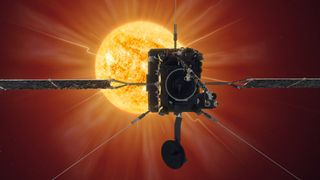The sun readies for its close-up as Europe's Solar Orbiter approaches
No spacecraft before has taken a camera so close to the sun.

The European Solar Orbiter mission will make its closest approach to the sun later this month, promising to capture images that could unravel some of the mysterious behaviours of the star at the heart of our solar system.
Solar Orbiter, a European Space Agency (ESA) mission with a contribution from NASA, launched in February 2020. It caused a stir already during its first close approach to the sun in June 2020 when the spacecraft's imagers captured never before seen phenomena on the sun's surface, the miniature solar flares nicknamed the campfires.
When those images were taken, Solar Orbiter was about half-way between Earth and the sun, at a distance of about 48 million miles (77 million kilometers). The upcoming approach will be even closer.
"From this point onwards, we are 'entering the unknown' as far as Solar Orbiter's observations of the sun are concerned," Daniel Müller, Solar Orbiter project scientist, said in an ESA statement Monday (March 7).
Solar Orbiter will photograph the sun from a distance of about 30 million miles (48 million kilometers). No spacecraft before has taken a camera so close to the sun, which means that Solar Orbiter will break its own 2020 record.
Related: Solar Orbiter captures its 1st video of eruption on the sun
"What I’m most looking forward to is finding out whether all these dynamical features we see [the campfires] can make their way into the solar wind or not," Louise Harra, the director of the World Radiation Centre of the Physical Meteorological Observatory in Davos, Switzerland, and one of the principal investigators of the mission, said in the statement. "There are so many of them!" she added.
Get the Space.com Newsletter
Breaking space news, the latest updates on rocket launches, skywatching events and more!
Solar wind is the constant stream of particles emanating from the sun that can cause geomagnetic storms on Earth that can wreak havoc with electrical grids and damage satellites orbiting the planet.
Scientists want to know whether the campfires (each between 250 to 2,500 miles wide) release their energy into the surrounding space, as it could explain why the sun's outer atmosphere, the corona, is so hot. At more than 1.7 million degrees F (1 million degrees C), the corona is much hotter than the solar surface, which has a temperature of about 9,900 degrees F (5,500 degrees C). The difference defies logic, as material farther away from the source of heat should be colder, not hotter.
To understand how the sun affects not only its immediate surroundings but the entire solar system, Solar Orbiter uses a suite of ten scientific instruments to take measurements of the star but also of the environment around the spacecraft.
The closest approach will take place on March 26, but Solar Orbiter will spend three weeks overall closer to the sun than the orbit of Mercury, the innermost planet of the solar system,
As the mission zooms in on the sun, it will be helped by spacecraft operating much closer to Earth. Japan's Hinode, NASA's Interface Region Imaging Spectrograph (IRIS) and ESA's Solar and Heliospheric Observatory (SOHO) will be watching for space weather effects while Solar Orbiter searches for the source.
"Such 'linkage science' is one of the main drivers behind the Solar Orbiter mission," ESA said of the spacecraft working together. "Even if no big event takes place, there is still a lot of science that can be performed in analyzing the evolution of the same packet of solar wind as it travels outwards into the solar system."
Another solar observing spacecraft by NASA, the Parker Solar Probe, is also making periodic dips to an extreme close distance to the sun. On Feb. 25, the heavily shielded spacecraft got within 5.3 million miles (8.5 million kilometers) of the solar surface, which is 14 times closer than Mercury's orbit.
During its future close passes, Solar Orbiter will get up to 26 million miles (42 million kilometres) to the Sun’s surface. Later in the mission, the spacecraft operators will tilt Solar Orbiter's orbit out of the ecliptic plane in which planets orbit to allow its cameras to look directly at the sun's poles. That will be another significant first.
Follow Elizabeth Howell on Twitter @howellspace. Follow us on Twitter @Spacedotcom or on Facebook.
Join our Space Forums to keep talking space on the latest missions, night sky and more! And if you have a news tip, correction or comment, let us know at: community@space.com.

Elizabeth Howell (she/her), Ph.D., is a staff writer in the spaceflight channel since 2022 covering diversity, education and gaming as well. She was contributing writer for Space.com for 10 years before joining full-time. Elizabeth's reporting includes multiple exclusives with the White House and Office of the Vice-President of the United States, an exclusive conversation with aspiring space tourist (and NSYNC bassist) Lance Bass, speaking several times with the International Space Station, witnessing five human spaceflight launches on two continents, flying parabolic, working inside a spacesuit, and participating in a simulated Mars mission. Her latest book, "Why Am I Taller?", is co-written with astronaut Dave Williams. Elizabeth holds a Ph.D. and M.Sc. in Space Studies from the University of North Dakota, a Bachelor of Journalism from Canada's Carleton University and a Bachelor of History from Canada's Athabasca University. Elizabeth is also a post-secondary instructor in communications and science at several institutions since 2015; her experience includes developing and teaching an astronomy course at Canada's Algonquin College (with Indigenous content as well) to more than 1,000 students since 2020. Elizabeth first got interested in space after watching the movie Apollo 13 in 1996, and still wants to be an astronaut someday. Mastodon: https://qoto.org/@howellspace
